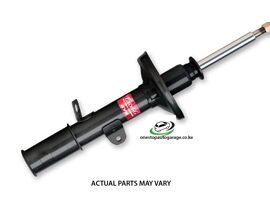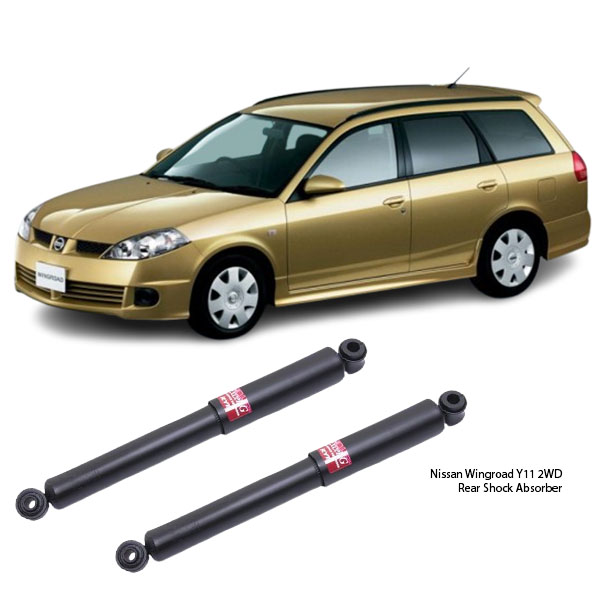-10%
Get Nissan Wingroad Y11 2WD Rear Shock Absorber Assy 343240 / 553258 in Kenya
The rear shock absorber assembly is a critical component of a vehicle’s suspension system. It plays a vital role in ensuring a smooth and stable ride by controlling the movement of the rear wheels and absorbing shocks from road imperfections. Without an effective shock absorber, a vehicle would experience excessive bouncing, reduced traction, and compromised handling, making driving uncomfortable and potentially unsafe.
This guide will provide an in-depth explanation of the rear shock absorber assembly, covering its functions, types, benefits, signs of wear, and maintenance tips to keep your vehicle performing at its best.
1. Understanding the Rear Shock Absorber Assembly
The rear shock absorber assembly consists of several interconnected components that work together to absorb and dissipate energy from road impacts. While specific designs vary depending on vehicle type and suspension system, a typical assembly includes:
- Shock Absorber (Damper): The core component responsible for controlling suspension movement.
- Mounting Bushings: Rubber or polyurethane components that cushion the connection points between the shock absorber and the chassis or suspension arms.
- Piston and Cylinder: The internal components where hydraulic or gas pressure dampens movement.
- Spring (if applicable): Some vehicles use a coilover design, where the shock absorber is integrated with a coil spring.
The primary purpose of the rear shock absorber assembly is to maintain stability, minimize vehicle oscillations, and improve handling by ensuring the wheels remain in contact with the road.
2. Functions of the Rear Shock Absorber Assembly
2.1 Damping Vibrations and Road Impacts
When driving over bumps, potholes, or uneven terrain, the suspension absorbs the impact, causing the wheels to move up and down. Without shock absorbers, this movement would continue indefinitely, leading to excessive bouncing. The shock absorber assembly absorbs this kinetic energy and converts it into heat, allowing the suspension to settle quickly.
2.2 Enhancing Vehicle Stability and Handling
A well-functioning shock absorber assembly ensures the vehicle remains stable during turns, acceleration, and braking. It prevents excessive body roll, squat (rear-end dipping when accelerating), and dive (front-end dipping when braking).
2.3 Maintaining Tire Contact with the Road
One of the most crucial roles of the rear shock absorber assembly is to keep the tires in constant contact with the road surface. If the wheels lose contact, even momentarily, it can lead to loss of control, especially on wet or uneven roads.
2.4 Reducing Wear on Suspension Components
By controlling excessive movement, the shock absorbers reduce stress on suspension parts, such as springs, bushings, and control arms. This extends the lifespan of these components and minimizes the need for frequent repairs.
3. Types of Rear Shock Absorbers
3.1 Twin-Tube Shock Absorbers
One of the most common types, twin-tube shocks consist of an inner working cylinder and an outer reservoir cylinder. These shocks use hydraulic fluid and a piston to absorb and dissipate energy.
3.2 Monotube Shock Absorbers
Unlike twin-tube designs, monotube shocks have a single tube containing both hydraulic fluid and gas (usually nitrogen). They provide better heat dissipation and more responsive damping, making them ideal for performance and off-road applications.
3.3 Gas-Charged Shock Absorbers
Gas shocks incorporate pressurized nitrogen gas to reduce aeration and fluid foaming, ensuring consistent performance under heavy loads or rough driving conditions.
3.4 Coilover Shock Absorbers
These shocks integrate a coil spring around the damper body, offering adjustability in ride height and stiffness. They are commonly used in performance and off-road vehicles.
3.5 Load-Assisting Shock Absorbers
Also known as air shocks or load-leveling shocks, these are designed to support heavier loads, making them ideal for SUVs, trucks, and towing applications.
4. Benefits of a Well-Maintained Rear Shock Absorber Assembly
✔️ Improved Ride Comfort: A well-functioning shock absorber minimizes road vibrations and sudden jolts, providing a smooth and comfortable driving experience.
✔️ Enhanced Handling and Safety: By reducing body roll and keeping tires in contact with the road, shock absorbers enhance vehicle control and stability.
✔️ Reduced Tire Wear: Proper damping prevents uneven tire wear caused by excessive bouncing or poor traction.
✔️ Extended Suspension Lifespan: Shock absorbers reduce stress on other suspension components, prolonging their durability.
✔️ Better Braking Performance: By preventing excessive weight transfer, shock absorbers help maintain optimal braking efficiency.
✔️ Improved Load Handling: Vehicles equipped with load-assisting shocks can carry heavy loads without excessive sagging or instability.
5. Signs of a Worn-Out Rear Shock Absorber Assembly
Over time, shock absorbers degrade due to normal wear and tear, road conditions, and driving habits. Common symptoms of a failing rear shock absorber assembly include:
❌ Excessive Bouncing: If your vehicle continues to bounce after hitting a bump, the shocks may be worn out.
❌ Poor Handling and Stability: Increased body roll, nose-diving when braking, or rear-end squatting when accelerating can indicate weak shock absorbers.
❌ Leaking Hydraulic Fluid: Visible oil leaks on the shock body suggest internal seal failure.
❌ Uneven Tire Wear: Worn shocks cause inconsistent tire contact with the road, leading to irregular tread wear patterns.
❌ Clunking or Rattling Noises: Loose or damaged shock absorbers can produce knocking sounds when driving over bumps.
❌ Longer Braking Distances: Compromised damping can lead to reduced braking efficiency and increased stopping distances.
6. Maintenance Tips for Rear Shock Absorbers
🔧 Inspect Regularly: Check shock absorbers every 20,000 to 30,000 km or as recommended by the manufacturer.
🔧 Look for Leaks: Examine the shock body for oil seepage or wet spots. If found, replacement is necessary.
🔧 Check for Loose Mountings: Ensure that bolts and bushings are tight and free from excessive wear.
🔧 Monitor Ride Quality: If you notice increased vibrations, bouncing, or poor handling, have the shocks inspected.
🔧 Replace in Pairs: Always replace rear shock absorbers in pairs to maintain balanced damping and stability.
🔧 Consider Upgrades: If you frequently carry heavy loads or drive on rough roads, consider gas-charged or load-adjusting shocks for better performance.
7. When to Replace Rear Shock Absorbers
Most manufacturers recommend replacing shock absorbers every 50,000 to 80,000 km, but this depends on factors like:
- Driving conditions (rough roads wear shocks faster)
- Vehicle load (heavier loads strain shocks)
- Driving habits (aggressive braking and acceleration increase wear)
If your vehicle exhibits any of the failure signs mentioned earlier, it’s time for a replacement.
Conclusion
The rear shock absorber assembly is an essential part of a vehicle’s suspension system, ensuring ride comfort, handling stability, and road safety. Choosing the right type of shock absorber, performing regular inspections, and replacing worn-out components on time can significantly enhance your vehicle’s performance and longevity.
If you experience poor ride quality, excessive bouncing, or uneven tire wear, have your rear shock absorbers inspected and replaced if necessary. By maintaining a healthy suspension system, you ensure a safer, smoother, and more enjoyable driving experience. 🚗💨
Follow us on Facebook for more parts.



Reviews
Clear filtersThere are no reviews yet.